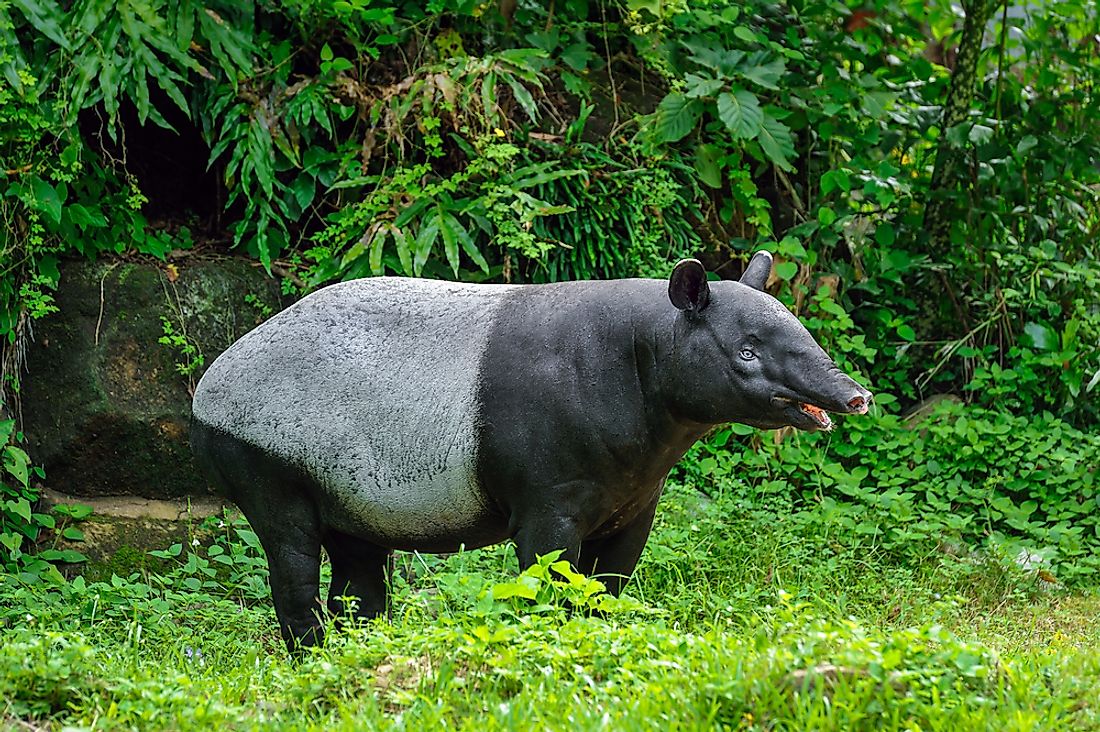The Five Species Of Tapirs Living In The World Today

A tapir is a herbivorous animal that is distinguished by the presence of a short, prehensile nose trunk. The rest of the appearance is similar to that of a pig. There are five extant species of tapirs. Four of these species live in the Americas while one is found in Asia. The horses, zebras, donkeys, and other odd-toed ungulates are closely related to the tapirs.
5. Brazilian Tapir
The Tapirus terrestris or the Brazilian tapir, also known as the South American tapir, is native to South America with significant populations being found in the Amazon basin and rainforest of the region. It is regarded as the Amazon’s largest living native terrestrial mammal. The size of the tapir excluding the tail varies between 5.9 and 8.2 feet. The animal has a dark brown body and paler face. Younger tapirs have white spots or stripes on the brown coat. The round ears of the tapir have distinctive white edges. The Brazilian tapirs are fast in water as well as on land. They can also move fast on rugged terrains. Crocodilians, big cats, and anacondas are their primary predators in their native habitat. The tapir is herbivorous in nature and its diet consists of plant parts. The IUCN classifies the species as “Vulnerable.” The tapirs are hunted for meat and hide. They are also losing their habitat at a fast pace.
4. Little Black Tapir
The little black tapir (Tapirus kabomani) is found in the Amazon rainforests of South America. It is the smallest extant species of tapir. It shares its habitat with the Brazilian tapir. The species has an average length of about 90cm. The species is darker in color than the Brazilian tapir. It also has shorter legs and crest than the T. terrestris. Little is known about the behavior of this species and it is considered to be a solitary animal but is occasionally seen in male-female pairs. Like other tapirs, the little black tapir is a herbivore feeding on fruits, grasses, leaves, etc. Since the species has been only recently discovered and classified, its conservation status is yet to be evaluated.
3. Mountain Tapir
The Tapirus pinchaque or the mountain tapir lives in a mountainous habitat in the Páramo and cloud forests of South America. The species is found at elevations ranging from 2,000 to 4,300 meters. The animal is also called the woolly tapir since it possesses a woolly coat that allows it to stay warm in the mountainous habitat. The woolly coat helps to easily identify this species. The coat of the species is very dark but paler on the cheeks, underside, and the anal region. The length of the species is around 5.9 feet. These animals feed on leaves, grasses, and other plant parts. They are significant agents of seed dispersal. The spectacled bears and cougars are the most common predators of the mountain tapir. The animals are crepuscular in nature. The mountain tapirs are labeled as “Endangered” by the IUCN and are the most threatened tapir species. Several factors like poaching for meat, hide and traditional medicines, habitat destruction, and persecution by farmers for consuming farmers’ crops, are some of the primary threats to the mountain tapir population.
2. Malayan Tapir
The Tapirus indicus or the Malayan tapir is the only species of tapir in the Old World. The species, also known as the Asian tapir, is native to Asia. It is the largest in size among the five species of tapirs. The most distinguishing physical character of this species is the light-colored patch extending between the shoulder and the rear end. The rest of the body is black in color. These animals have a poor eyesight but great sense of smell. They are generally solitary and territorial in nature. Their diet consists of 115 species of plants. They are crepuscular in nature. The Malayan tapir is a highly threatened species of tapir and is “Endangered” on the IUCN Red List. The species suffers from habitat destruction and poaching. It has very few natural predators in its habitat.
1. Baird's Tapir
The Tapirus bairdii or the Baird's tapir is a tapir species who range spreads from Mexico to northwestern South America including large parts of Central America. It is the largest terrestrial mammal i Central America with size ranging from 5.9 to 8.2 feet excluding the length of the stubby tail. The tapir has dark/grayish brown fur covering the body. They are primarily nocturnal and solitary in nature. They feed on fallen fruits and leaves of plants. They love to swim in the water and often tend to remain in waterholes during hot days. The Baird’s tapir must not be approached by humans as they are known to have charged and gored down humans on rare occasions. The IUCN classifies this species as “Vulnerable.” Habitat loss and poaching are the biggest threats to this species. Laws in several countries prohibit the hunting of these animals but are rarely enforced strictly.







